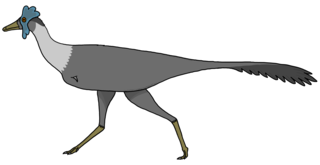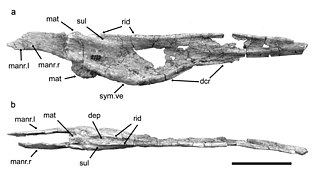
Argentinosaurus is a genus of giant sauropod dinosaur that lived during the Late Cretaceous period in what is now Argentina. Although it is only known from fragmentary remains, Argentinosaurus is one of the largest known land animals of all time, perhaps the largest, measuring 30–35 metres (98–115 ft) long and weighing 65–80 tonnes. It was a member of Titanosauria, the dominant group of sauropods during the Cretaceous. It is widely regarded by many paleontologists as the biggest dinosaur ever, and perhaps lengthwise the longest animal ever, though both claims have no concrete evidence yet.

Titanosaurs were a diverse group of sauropod dinosaurs, including genera from all seven continents. The titanosaurs were the last surviving group of long-necked sauropods, with taxa still thriving at the time of the extinction event at the end of the Cretaceous. This group includes some of the largest land animals known to have ever existed, such as Patagotitan—estimated at 37 m (121 ft) long with a weight of 69 tonnes —and the comparably-sized Argentinosaurus and Puertasaurus from the same region.

Aeolosaurus is a genus of titanosaurian sauropod dinosaur from the Late Cretaceous Period of what is now South America. Like most sauropods, it would have been a quadrupedal herbivore with a long neck and tail. Aeolosaurus is well known for a titanosaur, as it is represented by the remains of several individuals belonging to at least two species. However, like most titanosaurs, no remains of the skull are known. The holotype of Aeolosaurus rionegrinus consists of a series of seven tail vertebrae, as well as parts of both forelimbs and the right hindlimb. It was discovered in the Angostura Colorada Formation in Argentina, which dates from the Campanian stage of the Late Cretaceous, about 83 to 74 million years ago. The species A. maximus was transferred over to the new genus Arrudatitan in 2021.
Unenlagia is a genus of dromaeosaurid theropod dinosaur that lived in South America during the Late Cretaceous period. The genus Unenlagia has been assigned two species: U. comahuensis, the type species described by Novas and Puerta in 1997, and U. paynemili, described by Calvo et al. in 2004.

Ekrixinatosaurus is a genus of abelisaurid theropod which lived approximately 100 to 97 million years ago during the Late Cretaceous period. Its fossils have been found in Argentina. Only one species is currently recognized, Ekrixinatosaurus novasi, from which the specific name honors of Dr. Fernando Novas for his contributions to the study of abelisaurid theropods, while the genus name refers to the dynamiting of the holotype specimen. It was a large abelisaur, measuring between 6.5 and 8 m in length and weighing 800 kg (1,800 lb).

Futalognkosaurus is a genus of titanosaurian dinosaur. The herbivorous Futalognkosaurus lived approximately 87 million years ago in the Portezuelo Formation, in what is now Argentina, of the Coniacian stage of the late Cretaceous Period. The fish and fossilized leaf debris on the site, together with other dinosaur remains, suggest a warm tropical climate in Patagonia during this period.
Mendozasaurus is a genus of titanosaurian sauropod dinosaur. It was a member of Titanosauria, which were massive sauropods that were common on the southern landmasses during the Cretaceous. It is represented by several partial skeletons from a single locality within the Coniacian Sierra Barrosa Formation in the south of Mendoza Province, northern Neuquén Basin, Argentina. The type species, Mendozasaurus neguyelap, was described by Argentine paleontologist Bernardo Javier González Riga in 2003. Mendozasaurus is the first dinosaur named from Mendoza Province, Argentina, for which it was named.
Muyelensaurus is a genus of titanosaurian sauropod dinosaur from the Late Cretaceous of Argentina. It was more slender than other titanosaurs. Fossils have been recovered in the Neuquén province of Patagonia and were originally assigned to the Portezuelo Formation but further research showed that these layers belong to the Plottier Formation. The type species is M. pecheni. The name Muyelensaurus first appeared in a 2007 paper by Argentine paleontologists Jorge Calvo of the Universidad Nacional del Comahue and Bernardo González Riga of the Laboratorio de Paleovertebrados, and Brazilian paleontologist Juan Porfiri of the Universidade Federal do Rio de Janeiro.

Austroraptor is a genus of dromaeosaurid theropod dinosaur that lived during the Campanian and Maastrichtian ages of the Late Cretaceous period in what is now Argentina.
Traukutitan is a genus of titanosaur sauropod dinosaur which lived during the late Cretaceous.

Jorge Orlando Calvo was an Argentine geologist and paleontologist working for "Centro de Investigaciones Paleontológicas Lago Barreales".

Pamparaptor is an extinct genus of maniraptoran theropod dinosaur from the Late Cretaceous Portezuelo Formation of the Neuquén province in Argentine Patagonia. Its precise classification is uncertain, but it is definitely a member of Paraves and probably a deinonychosaur. The authors who described it have argued that it is a dromaeosaurid. The genus contains a single species, P. micros, which is known from a single specimen consisting of a mostly complete and fully-articulated left foot, which preserves the iconic dromaeosaur-like “killing claw”.

Aeolosaurini is an extinct clade of titanosaurian dinosaurs known from the Cretaceous period of Argentina and Brazil. Rodrigo M. Santucci and Antonio C. de Arruda-Campos (2011) in their cladistic analysis found Aeolosaurus, Gondwanatitan, Maxakalisaurus, Panamericansaurus and Rinconsaurus to be aeolosaurids.

Bonapartenykus is a monospecific genus of alvarezsauroid dinosaur from Argentina that lived during the Late Cretaceous (Campanian-Maastrichtian) in what is now the upper Allen Formation of the Río Negro Province. The type and only species, Bonapartenykus ultimus, is known from a nearly articulated but partial skeleton that was found in close association to two incomplete eggs and several clusters of eggshells belonging to the oogenus Arriagadoolithus. Bonapartenykus was named in 2012 by Federico L. Agnolin, Jaime E. Powell, Fernando E. Novas and Martin Kundrát. Bonapartenykus has an estimated length of 2.5 m (8.2 ft) and weight of 72 kg (159 lb), making it the largest member of the clade Alvarezsauroidea.

Overosaurus is an extinct genus of sauropod dinosaurs, containing only a single species, Overosaurus paradasorum. This species lived approximately 86 to 84 million years ago during the latter part of the Cretaceous Period in what is now Patagonia. Overosaurus paradasorum was relatively small compared to other sauropods from Patagonia, like the saltasaurids and other aeolosaurines, estimated as approximately 10 m (33 ft). It was a ground-dwelling herbivore.

Notocolossus is a genus of titanosaurian sauropod dinosaur from late Cretaceous strata of Mendoza Province, Argentina.
Choconsaurus is an extinct genus of herbivorous sauropod dinosaur belonging to the group Titanosauriformes, which lived in the area of present-day Argentina at the end of the Cretaceous.

Rinconsauria is an extinct clade of giant titanosaurian sauropods known from the late Cretaceous period of Argentina.

Argentinadraco is an extinct genus of azhdarchoid pterosaur from the Late Cretaceous Portezuelo Formation of Argentina. It contains a single species, A. barrealensis, named in 2017 by Alexander Kellner and Jorge Calvo. Argentinadraco is unusual for bearing a bottom jaw with a concave bottom edge, as well as a pair of ridges and depressions on the top surface. These features distinguish it from all other azhdarchoid groups, complicating its assignment, but it may belong to the Chaoyangopteridae. The ridges on the lower jaw may have been used to feed on small invertebrates in loose sediment within the system of lakes and rivers that it resided in.
Punatitan is a genus of titanosaurian sauropod dinosaur from the Late Cretaceous Ciénaga del Río Huaco Formation of La Rioja, Argentina. It contains one species, Punatitan coughlini.

























